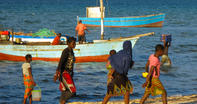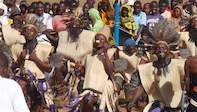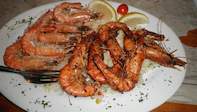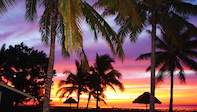
Learn more about the country of Mozambique, from its history, culture, climate, geography and customs. Everything you need to know.
Best Beaches in Mozambique
In the far south are endless dune-backed sands at Ponta do Ouro and Ponta Malongane, beloved by South African fishermen and divers. Outstanding palm-fringed beaches occur throughout Inhambane Province, especially within 30km of Inhambane town.
To the north are Tofo and Barra beaches; to the secluded south, Jangamo and Paindane Beaches and Coconut Bay. Consisting of sand dunes, the Bazaruto Islands are all fringed by kilometres of unbroken, untouched beach. Wimbe, outside Pemba, is a long strip of white sand with bars and a dive centre. The Quirimbas, 27 offshore islands of fossil coral rock in the far north, harbour innumerable intimate castaway beaches.
Learn more in our Mozambique Beach Guide
Wildlife of Mozambique
Mozambique's best-known national park has no safari game: Bazaruto NP is a marine reserve, home to the endangered dugong and many coral and fish species. Humpback whales visit between September and November, heading north with newborn calves, and can also be seen in Pemba Bay in July-August. Sadly, many of Mozambique's other NPs don't have much game either.
Protected land forms 11% of the country, but war and poaching have taken a tragic toll on erstwhile rich wildlife populations, and park infrastructure remains sparse. Gorongosa NP, a large area of brachystegia woodland above the Beira Corridor, was once Mozambique's flagship, with 12,000 annual visitors and more game than Kruger, but few animals survived the war.
Rehabilitation has included de-mining, bridge building and lodge repair. Wildlife - including lion, buffalo, sable and elephant - is drifting back slowly. In the remote north, game is more prolific. New tourism ventures are penetrating the diverse Niassa Game Reserve, bordering Tanzania, where the 2002 aerial census put the elephant population at 12,000.
Overall the situation is slowly improving due to restocking, natural regeneration and transfrontier Peace Parks projects. Mozambique's government is investing R109m in restocking and upgrading Limpopo NP, which will be linked with South Africa's Kruger and Zimbabwe's Gona-re-Zhou, forming the Greater Limpopo Transfrontier Park. The planned Lubombo Transfrontier Park will join the Maputo Elephant reserve with protected areas in South Africa and Swaziland.
Learn more about Mozambique wildlife
Birds
With 30 species that are endemic or have their main populations here, including the Madagascar squacco heron, Palmnut vulture and Boehm's bee-eater, Mozambique is important for Southern African avifauna.
Mount Gorongosa's montane forest is excellent for birding, the diverse Niassa Reserve supports outstanding avian life, and migrating species frequent the coast. The north hosts several species absent from the south, including the Pale-billed hornbill and White-tailed blue flycatcher, and with large areas still unexplored, it's expected that the list will grow.
People of Mozambique

Mozambique's people are 98% African, the remainder being European, Indian, and mestiços (mixed race). Historically the Zambezi divides matrilineal agriculturalists from the north-west from patrilineal pastoralists who once fled the violent Zulu kingdom to the south.
Around 50% of Mozambicans still follow traditional African religions; 28% (mainly urban) are Christian and 22% Muslim (mostly in the north). Simple rules of respect apply when meeting Mozambicans: ask permission before wandering through villages or photographing people or places of worship. Haggle only within reason - remember your relative wealth compared to those you're buying from.
Learn more about Mozambique Culture and Customs
Architecture, Art and Crafts
Mozambican's historical stars are the north's Portuguese colonial relics. Ilha do Moçambique, the country's 19th century capital, has UNESCO World Heritage status for its extraordinary 16th century fortress (containing the Church of Senhora Baluarte, the southern hemisphere's oldest extant European building), palace, cathedrals, ruined hospital and collection of crumbling villas.
Further north and equally atmospheric, Ibo Island has a smaller slave-trading fortress and tumbleweed streets of overgrown houses, gradually being restored by enterprising investors. In the south, Inhambane town is the best example of Iberian old-world charm.
Outside Tete, Baroma Mission has a distinctive Portuguese church and attractive buildings (now housing a school) overlooking the Zambezi. Mozambique also nurtures a rich African artistic vein. Its painters' distinctive and powerful cartoon-like style is most evident in Maputo's outsized street murals.
Many were painted spontaneously post-independence, often with revolutionary themes. Among the best is a 95-metre example by the Praça dos Heróis. Downtown, the Museu Nacional des Artes has excellent contemporary and war art, often starkly revealing of Mozambicans' anguish during the conflict.
The Nucleo de Arte exhibits local artists in an informal workshop environment - look out for extraordinarily clever, if disturbing, sculptures made from AK47s and handguns from the war. Curio sellers on Avenida 24 de Julho and near the Polana peddle unusual work, typically of high quality - alongside carvings of people and animals are superb model cars, elegant colourful abstract bird carvings, elaborate picture frames and boxes inlaid with wood and bone.
Northern Mozambique is famous for Makonde carvings in sandalwood, rosewood and ebony: beautiful depictions of family groups, towers of linked figures, people undertaking daily tasks and mischievous long-eared devils. Nampula's Museu Nacional de Entologica has a dusty, intriguing ethnographic collection of extraordinary masks and old musical instruments. Behind the museum, the Makonde carvers' collective is a good place to shop and watch working craftsmen, as is the cooperative on Pemba's Wimbe road.
Food and Drink

A Portuguese influence rich in garlic and olive oil pervades Mozambican cuisine. The country's signature dishes are piri-piri chicken or large prawns, served with a hot red chilli sauce and rice or chips. Fish and calamari are ubiquitous along the coast. Steak rolls, choriço or cheese sandwiches are typical snacks.
Traditional African ingredients include coconut, cassava, pumpkin, peanuts and nçima (stiff maize-meal porridge). Better restaurants serve Portuguese wines and port. Manica and 2M (pronounced 'dosh M') are the local beers. Bottled water is widely available - check the seals.
Learn more about the Food of Mozambique
Activities
Water-based activities are Mozambique's forte, with world-class diving and snorkelling from Ponta D'Ouro to the Quirimbas. The Bazaruto Archipelago is the most developed playground, with diving, sailing, dhow and deep-sea fishing excursions from the islands and Vilanculos. Further north, the St Lazarus Banks off Pemba are a game fisherman's Holy Grail.
On dry land, Indigo Bay on Bazaruto offers horse riding and dune-boarding. The archipelago is good for walking as it's free from landmines. On the mainland never stray into dunes or bush without checking first that the area has been officially cleared. Ugezi Tiger Lodge on Lake Cahora Bassa offers rewarding bream and tiger fishing in a wild setting and also arranges visits to the impressive dam wall.
Find out more about Mozambique Holiday Activities
When to Go
Mozambique's warm tropical climate varies with altitude and latitude, the north-east coastal regions generally being hotter and more humid than the south. The cooler dry season from April-September is the best time to travel.
October to April is the hotter rainy season, when risks of malaria and washed-out roads are greater (though the south receives far less rain than the north). Beware South African school holidays, when southern Mozambique (up to Vilanculos) is often fully booked. Holiday dates vary but are based around three weeks (late March-mid-April); a month (late-June-late July); a fortnight (late September) and six weeks (early December-mid January).
Best Time to Travel to Mozambique
Currency
The unit of currency is the metical (MT), plural: meticais (roughly MT23,000 per US$). US Dollars and South African Rand are easiest to change, sterling less so, especially away from major centres. Bank notes come in large denominations (up to MT100,000) so it's useful to keep smaller notes with you as vendors often don't have change.
Language
Portuguese, the official language, is spoken by only the quarter of the population who went to school. Roughly 60 distinct Bantu languages and dialects are also spoken, including KiSwahili along the northern coast. English is understood in the Tete Corridor between Zimbabwe and Malawi, and in the far south, reflecting close links with Johannesburg. It's worth learning basic Portuguese phrases, if only for courtesy.
Getting to Mozambique

TAP Air Portugal and LAM, Mozambique's airline, fly direct from Lisbon to Maputo; TAP has London-Lisbon connections. Alternatively, fly to Johannesburg and catch connecting flights to Maputo with South African Airways or LAM, or to Pemba with SAA.
Lodges in the Bazaruto Archipelago will arrange direct flights from South Africa for their clients. Pelican Air and Charlan Air fly from Kruger-Mpumalanga airport to Vilanculos. Numerous local bus services enter Mozambique from neighbouring countries but the easiest overland option for tourists is the daily Panthero Azul luxury coach from Johannesburg or Durban.
Getting Around
Unless you have limitless time, internal flights are the best way to negotiate Mozambique's great distances. LAM operates between all the main hubs. Reliable bus services link cities, especially in the south, although the area between Beira and Nampula remains a public transport black hole.
Safety: Mozambique is as safe as any African country. Common-sense rules apply: don't wear expensive jewellery, carry bundles of cash or flaunt your wealth, and don't walk alone at night.
Info: Mozambique, The Bradt Travel Guide, by Philip Briggs and Ross Velton
Cucumbers: Travels in Mozambique by Nick Middleton (Phoenix, 1994) - excellent travelogue with insightful background.

 Relatively unknown among African safari travelers, many who do not know where the country is, Mozambique lies on the Indian Ocean between th...
Relatively unknown among African safari travelers, many who do not know where the country is, Mozambique lies on the Indian Ocean between th... The first written record of Mozambique dates from the 10th century AD, when Arab writer al-Mas'udi mentioned the town of Sofala (south of pr...
The first written record of Mozambique dates from the 10th century AD, when Arab writer al-Mas'udi mentioned the town of Sofala (south of pr... Mozambique's 2,500 km of Indian Ocean coastline is mainly made up of empty, palm-fringed, sandy beaches where luxury Mozambique hotels...
Mozambique's 2,500 km of Indian Ocean coastline is mainly made up of empty, palm-fringed, sandy beaches where luxury Mozambique hotels... Traditional ways of life are well preserved in Mozambique - varying from province to province. This cultural kaleidoscope provides visitors ...
Traditional ways of life are well preserved in Mozambique - varying from province to province. This cultural kaleidoscope provides visitors ... Find out more about the culture and customs of the local people of Mozambique. What languages are spoken in Mozambique? The official languag...
Find out more about the culture and customs of the local people of Mozambique. What languages are spoken in Mozambique? The official languag... The Bantu people settled in Mozambique about 2,000 years ago, setting up the great Mwenemutapa Empire in the centre and south of the country...
The Bantu people settled in Mozambique about 2,000 years ago, setting up the great Mwenemutapa Empire in the centre and south of the country... The Mozambican Flag has been the subject of much debate as it is the only flag in the world to have a symbol of a modern weapon and as such ...
The Mozambican Flag has been the subject of much debate as it is the only flag in the world to have a symbol of a modern weapon and as such ... The National Emblem of Mozambique, adopted in 1990, signifies its socialist beginnings and strives to describe the resourcefulness through r...
The National Emblem of Mozambique, adopted in 1990, signifies its socialist beginnings and strives to describe the resourcefulness through r... Maputo, the capital city of Mozambique, is located to the south of the country. Formerly known as Lourenco Marques, it evokes much of the at...
Maputo, the capital city of Mozambique, is located to the south of the country. Formerly known as Lourenco Marques, it evokes much of the at...